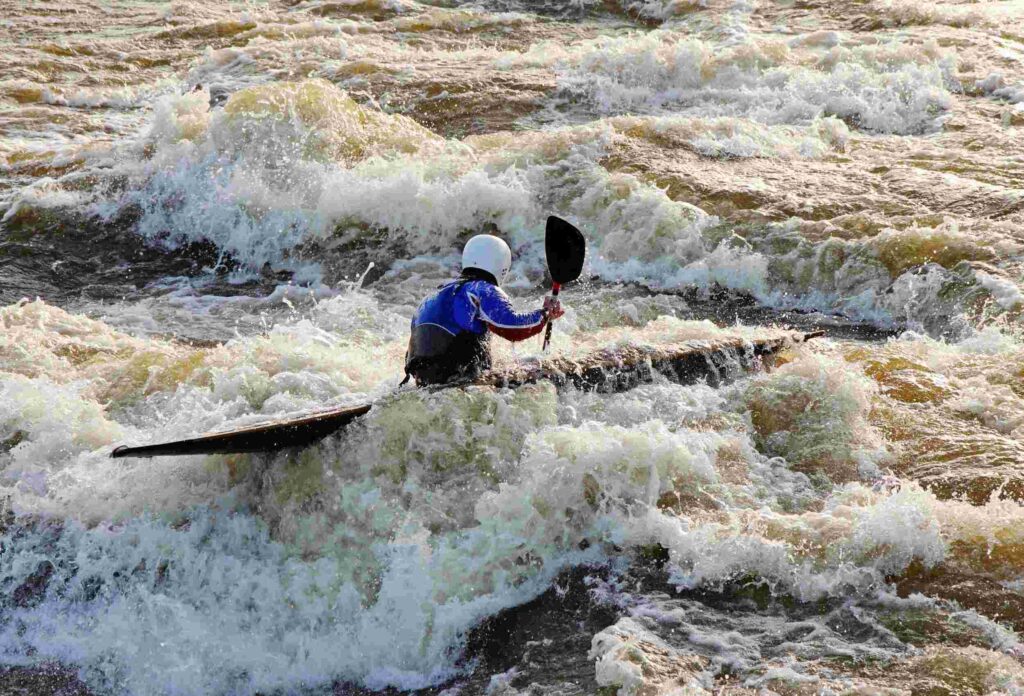Kayaking travel insurance is a reliable way of protection for enthusiasts of extreme sports, including swimming sea kayaking, whitewater rafting, or canoeing.
Kayaking is an exciting form of active recreation that involves moving on specialized boats called kayaks. It is both a dangerous activity and a means of traveling on water.
Types of Kayaking
There are two main types of kayaking based on the location: Whitewater and Sea.
Whitewater involves descending fast-flowing rivers with rapids and whirlpools. It requires participants to be physically fit and have good technique. Swimmers sit in specialized river kayaks and navigate the river, overcoming various obstacles. When engaging in Whitewater kayaking, it is important to prioritize safety and use specialized equipment.

Sea kayaking is paddling in the sea or ocean. It can be both calm and more extreme. Different types of boats are used depending on the level of difficulty. For example, in challenging conditions, participants use kayaks with closed cockpits that protect against water entry. This type of kayaking requires not only good physical fitness but also knowledge of water safety.

Kayaking Rapids Classes
There are universally accepted categories for evaluating the difficulty level of a kayaking trip. While some organizations may use their own rating systems, the most common classification is the scale ranging from 1 to 6.

- Class 1 rapids are gentle currents without waves or obstacles. Here, one can kayak peacefully even without any skills.
- Class 2 rapids already have small waves and minor barriers that may require some quick maneuvers. While they add an adrenaline rush, the risk of injury is minimal.
- Level 3 kayaking is more challenging. It involves high waves and small obstacles. On such rapids, one needs a certain level of experience and boat handling skills. The danger increases, but still remains relatively low.
- Grade 4 rapids pose a significant risk for inexperienced kayakers. Navigating these rapids requires excellent kayak control techniques and good physical fitness. Despite the high danger, serious injuries can be avoided with the right approach.
- Grade 5 is true extreme kayaking. Large waves, fast currents, and numerous obstacles on these rapids demand maximum concentration and professional mastery of techniques.
- Class 6 rapids represent the highest level of difficulty. There is little chance of survival without special training and equipment. Only highly experienced professional kayakers would take on such a risk.
Let’s take a look at the table to see what different countries around the world offer for kayaking experiences.
| Location | Type | Difficulty | Duration | Cost |
| Colorado, USA | Whitewater | Intermediate | Half-day | $100 – $150 |
| Alps, France | Whitewater | Advanced | 1-2 days | €200 – €300 |
| West New Zealand | Whitewater | Beginner | Half-day | NZD 150 |
| Quebec, Canada | Whitewater | Intermediate | 1 day | CAD 120 |
| Norwegian Fjords | Sea | Beginner | Half-day | 800 NOK |
| Barbados | Sea | Beginner | Half-day | $80 |
Insurance Features
If you plan to engage in kayaking during your travels, it is advisable to purchase travel insurance. Sea kayaking travel insurance can be beneficial regardless of the destination, as it offers optimal conditions for ensuring your safety nationwide.
To choose the optimal insurance option for kayakers, it is recommended to compare the available options. Review information on prices, customer reviews, and compare the policy coverage with your needs and goals. Travel insurance for sea kayaking may include additional services such as equipment coverage or emergency evacuation if needed.

The cost of river kayaking travel insurance may vary depending on the nature of the trip. If you purchase insurance for a single trip, its price will be lower than for multiple trips. However, if you travel frequently and visit multiple destinations within 12 months, it is better to purchase an annual insurance policy.
Remember that travel insurance for kayaking provides you with peace of mind and kayak trip protection during your vacation. Therefore, it is important to carefully consider the type of insurance and take into account all your travel needs.
FAQ
When choosing travel insurance for kayaking, consider factors such as the type of kayaking, coverage amount, cost, and insurance terms. It is important to find an option that covers all risks associated with kayaking.
Coverage during kayak trip insurance can include medical expenses, accident insurance, property insurance, liability coverage, and more. The coverage depends on the selected type of insurance.
In the event of a critical situation, contact your insurance company and file a claim for the insurance coverage. Usually, you will need to provide documents confirming the purchase of travel insurance for kayaking and await the reimbursement of the claimed amount.
